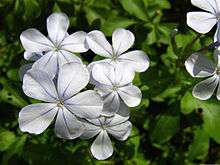Plumbago
| Plumbago | |
|---|---|
 | |
| Plumbago auriculata | |
| Scientific classification | |
| Kingdom: | Plantae |
| (unranked): | Angiosperms |
| (unranked): | Eudicots |
| (unranked): | Core eudicots |
| Order: | Caryophyllales |
| Family: | Plumbaginaceae |
| Subfamily: | Plumbaginoideae |
| Genus: | Plumbago L.[1] |
| Type species | |
| Plumbago europaea L. | |
Plumbago is a genus of 10–20 species of flowering plants in the family Plumbaginaceae, native to warm temperate to tropical regions of the world. Common names include plumbago and leadwort (names which are also shared by the genus Ceratostigma).
Description
The species include herbaceous plants and shrubs growing to 0.5–2 m (1.6–6.6 ft) tall. The leaves are spirally arranged, simple, entire, 0.5–12 cm (0.20–4.72 in) long, with a tapered base and often with a hairy margin. The flowers are white, blue, purple, red, or pink, with a tubular corolla with five petal-like lobes; they are produced in racemes.
The flower calyx has glandular trichomes (hairs), which secrete a sticky mucilage that is capable of trapping and killing insects; it is unclear what the purpose of these trichomes is; protection from pollination by way of "crawlers" (ants and other insects that typically do not transfer pollen between individual plants), or possible protocarnivory.[2]
Mature plumbago leaves often have a whitish residue on their undersides, a feature that can confuse gardeners. While this white material resembles a powdery mildew disease or a chemical spray deposit, it is actually a natural exudate from "chalk" glands that are found on the Plumbago species.[3]
Taxonomy
The generic name, derived from the Latin words plumbum ("lead") and agere ("to resemble"), was first used by Pliny the Elder (23-79) for a plant known as μολυβδαινα (molybdaina) to Pedanius Dioscorides (ca. 40-90).[4][5] This may have referred to its lead-blue flower colour, the ability of the sap to create lead-colored stains on skin,[6] or Pliny's belief that the plant was a cure for lead poisoning.[7]
The following species are accepted by The Plant List:[8]
- Plumbago amplexicaulis Oliv.
- Plumbago aphylla Bojer ex Boiss.
- Plumbago auriculata Lam.
- Plumbago ciliata Engl. ex Wilmot-Dear
- Plumbago coerulea Kunth
- Plumbago dawei Rolfe
- Plumbago europaea L.
- Plumbago glandulicaulis Wilmot-Dear
- Plumbago indica L.
- Plumbago madagascariensis M. Peltier
- Plumbago montis-elgonis Bullock
- Plumbago pearsonii L. Bolus
- Plumbago pulchella Boiss.
- Plumbago stenophylla Wilmot-Dear
- Plumbago tristis Aiton
- Plumbago wissii Friedr.
- Plumbago zeylanica L.
See also
References
- ↑ "Plumbago L.". Germplasm Resources Information Network. United States Department of Agriculture. 2002-01-02. Retrieved 2010-01-29.
- ↑ Schlauer, Jan (1997). ""New" data relating to the evolution and phylogeny of some carnivorous plant families". Carnivorous Plant Newsletter. International Carnivorous Plant Society. 26 (2): 34–38.
- ↑ Doug Caldwell. New thrips found on Plumbago (PDF). Collier County Extension, University of Florida & Institute of Food and Agricultural Sciences.
- ↑ Quattrocchi, Umberto (2000). CRC World Dictionary of Plant Names. 3 M-Q. CRC Press. p. 2117. ISBN 978-0-8493-2677-6.
- ↑ Austin, Daniel F. (2004). Florida Ethnobotany. CRC Press. pp. 527–528. ISBN 978-0-8493-2332-4.
- ↑ Schmelzer, G.H.; A. Gurib-Fakim (2008). Medicinal Plants. Plant Resources of Tropical Africa. p. 427. ISBN 978-90-5782-204-9.
- ↑ Burke, Don (2005). The Complete Burke's Backyard: the Ultimate Book of Fact Sheets. Murdoch Books. p. 268. ISBN 978-1-74045-739-2.
- ↑ "Plumbago". The Plant List. Retrieved 31 March 2017.
External links
| Wikimedia Commons has media related to Plumbago. |
| Wikispecies has information related to: Plumbago |
- Flora of Chile: Plumbago (pdf file)
- Flora of China: Plumbago
- Flora of Ecuador: Plumbago
- Flora Europaea: Plumbago
- Flora of North America: Plumbago
- Flora of Pakistan: Plumbago

